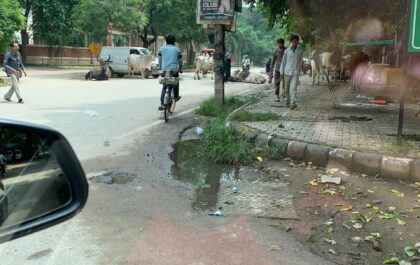As one navigates the sector roads, a sense of dismay washes over at the blatant disregard for civic sense displayed by supposedly educated individuals. They seem determined to encroach upon every available inch of public space, with no regard for the law or the inconvenience caused to others. Legally, any area beyond the boundary wall is designated for public use. While parking cars parallel to one’s residence is reasonable, the encroachment does not stop there. In a shocking act of audacity, one resident in Sector 36 has not only encroached upon the footpath but also removed the tiles. This begs the question: are members of the general public allowed to modify public property at will?
The 9-metre roads were not designed to accommodate encroachments, which obstruct the free flow of traffic. Gardens, security cabins, generator housings, and other permanent structures have sprung up, flouting all rules. Despite multiple notices from the authorities, urging residents to demolish these encroachments, no concrete action has been taken. The lack of enforcement, be it in the form of fines or bulldozing, renders these notices mere formalities. The government can enact numerous laws and pass judgments, but the million-dollar question remains: how to implement these laws effectively? Sector 36 is a prime example of the encroachment epidemic, with markets and narrow lanes bearing witness to this persistent problem. Residents have taken to beautifying the areas in front of their houses with potted plants and colourful flowers, fencing them off and conveniently parking their cars on the road. This encroachment consumes half the road space, making it challenging for commuters to navigate the stretch. The situation often escalates into heated exchanges between drivers when two cars approach from opposite directions.
The encroachments are not limited to cars or beautified areas; generator sets, construction materials, and even debris (Malba) litter the spaces outside houses. These obstructions not only render turns blind but also create accident-prone zones. It is evident that laws and authority-led actions alone cannot curb this nuisance. A collective understanding that public spaces are not meant for personal use, as it causes inconvenience to others, is essential to combat this encroachment epidemic.







Popular Stories
Football Tournament @Princeton
More Than a Festival: The Art and Power of Durga Puja
Personality of the Month- ‘Dr Usha Mediratta’
Stray Cattle Menace In Front of Galleria
The Chronicles of Malibu Towne: A Mosquito’s Tale
“Senior Living Is Not An Old Age Home” say Mr & Mrs Bose
Recent Stories from Nearby
- A Story of Compassion January 28, 2025
- ‘The Power Of Imperfect Eating’ By Kavita Bhatnagar January 28, 2025
- New on the road January 28, 2025
- Khichdi Celebration January 28, 2025
- Canine Care January 28, 2025







